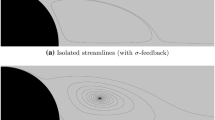Abstract
The use of the Helmholtz decomposition for exterior incompressible viscous flows is examined, with special emphasis on the issue of the boundary conditions for the vorticity. The problem is addressed by using the decomposition for the infinite space; that is, by using a representation for the velocity that is valid for both the fluid region and the region inside the boundary surface. The motion of the boundary is described as the limiting case of a sequence of impulsive accelerations. It is shown that at each instant of velocity discontinuity, vorticity is generated by the boundary condition on the normal component of the velocity, for both inviscid and viscous flows. In viscous flows, the vorticity is then diffused into the surroundings: this yields that the no-slip conditions are thus automatically satisfied (since the presence of a vortex layer on the surface is required to obtain a velocity slip at the boundary). This result is then used to show that in order for the solution to the Euler equations to be the limit of the solution to the Navier-Stokes equations, a trailing-edge condition (that the vortices be shed as soon as they are formed) must be satisfied. The use of the results for a computational scheme is also discussed. Finally, Lighthill's transpiration velocity is interpreted in terms of Helmholtz decomposition, and extended to unsteady compressible flows.
Similar content being viewed by others
References
Batchelor, G.K. (1967): An introduction to fluid dynamics. Cambridge: Cambridge Univers. Press
Bykhovskiy, E.B.; Smirnov, N.V. (1960): On orthogonal expansions of the space of vector functions which are square-summable over a given domain and the vector analysis operators. Trudy Mat. Inst. Steklova 59, 5. Academy of Sciences USSR Press, pp. 5-36. (Also available as NASA TM-77051, 1983)
Campbell, R.G. (1973): Foundations of fluid flow theory, p. 258. Reading: Addison-Wesley Publ.
Del Marco, S.P. (1986): The mathematical foundations of the scalar-vector potential approach to analysing viscous flows. Ph.D. Thesis, Boston Univers. Dept. of Mathematics
El Refaee, M.M.; Wu, J.C.; Lekoudis, S.G. (1982): Solutions of the compressible Navier-Stokes equations using the integral method. AIAA J. 20, 356–362
Hess, J.L. (1977): A fully automatic combined potential-flow boundary layer procedure for calculation viscous effects on the lifts and pressure distributions of arbitrary three-dimensional configurations. Long Beach: Douglas Aircraft Co., MDC J7491
Hirasaki, G.J.; Hellums, J.D. (1968): A general formulation of the boundary conditions of the vector potential in three-dimensional hydrodynamics. Quart. Appl. Math. 26, 331–342
Hirasaki, G.J.; Hellums, J.D. (1970): Boundary conditions on the vector and scalar potentials in viscous three-dimensional hydrodynamics. Quart. Appl. Math. 28, 293–296
Joukowski, N. (1907): On the adjunct vortices, (in Russian). Obshchestvo liubitelei estestvoznaniia, antropologii i etnografee, Moskva, Izaviestiia, 112, Transactions of the Physical Section, vol. 13, pp. 12–25
Kutta, J. (1902): Auftriebskräfte in strömenden Flüssigkeiten. Illustrierte Aueronautische Mitteilungen, vol. 6, pp. 133–135
Ladyzhenskaya, O.A. (1963): The mathematical theory of viscous incompressible flows. New York: Gordon and Bread
Lamb, H. (1932): Hydrodynamics, 6th ed. Cambridge: Cambridge University Press
Lemmerman, L.A.; Sonnad, V.R. (1979): Three-dimensional viscous-inviscid coupling using surface transpiration. J. Aircraft 16, 353–358
Lighthill, M.J. (1958): On displacement thickness. J. Fluid Mech. 4, 383–392
Lighthill, M.J. (1963): Introduction to boundary layer theory. In: Rosenhead, L. (ed): Laminar boundary layers, part 2, pp. 46–113. Oxford: Oxford University Press
Maskew, B. (1982): Prediction of subsonic aerodynamic characteristics: A case for low-order panel methods. J. Aircraft 19, 157–163
Morino, L. (1973): Unsteady compressible flow around lifting bodies: General theory. AIAA Paper No. 73-196, AIAA 11th Aerospace Sciences Meeting, Washington, D.C.
Morino, L. (1974): A general theory of unsteady compressible potential aerodynamics. NASA CR-2464
Morino, L. (1985): Scalar/vector potential formulation for compressible viscous unsteady flows. NASA CR-3921
Morino, L. (1986): Material contravariant components: Vorticity transport and vortex theorems. AIAA J. 26, No. 3, 526–528
Morino, L.; Bharadvaj, B. (1985): Two methods for viscous and inviscid free-wake analysis of helicopter rotors. Boston: Boston University, CCAD-TR-85-02
Morino, L.; Kaprielian, Z., Jr.; Sipcic, S.R. (1985): Free wake analysis of helicopter rotors. Vertica 9, 127–140
Morino, L.; Kuo, C. C. (1974): Subsonic potential aerodynamics for complex configurations: A general theory. AIAA J. 12, 191–197
Morton, B.R. (1984): The generation and decay of vorticity. Geophys. Astrophys. Fluid Dynamics 28, 277–308
Quartapelle, L.; Valz-Gris, F. (1981): Projection conditions on the vorticity in viscous incompressible flows. Internal. J. for Numerical Methods in Fluids, 1, 129–144
Richardson, S.M.; Cornish, A.R.H. (1977): Solution of three-dimensional incompressible flow problems. J. Fluid Mech. 82, 309–319
Serrin, F. (1959): Mathematical principle of classical fluid mechanics. In: Fluegge, S. (ed): Encyclopedia of physics, Vol. VIII/1, Fluid Dynamics I. Berlin, Göttingen, Heidelberg: Springer
Soohoo, P.; Noll, R.B.; Morino, L.; Ham, N.D. (1978): Rotor wake effects on hub/pylon flow, vol. 1, Theoretical formulation. Appl. Technology Lab., U.S. Army Research and Technology Laboratories (AVRADCOM), Fort Eustis, Va., USARTL-TR-78-1A, p. 108
Sugavanam, A.; Wu, J.C. (1982): Numerical study of separated turbulent flow over airfoils. AIAA J. 20, 464–470
Thompson, J.F.; Shanks, S.P.; Wu, J.C. (1974): Numerical solution of three-dimensional Navier-Stokes equations showing trailing edge vortices. AIAA J. 12, 787–794
Weyl, H. (1940): The method of orthogonal projection in potential theory. Duke Math. J. 7, 411–444
Wu, J.C. (1976): Numerical boundary conditions for viscous flow problems. AIAA J. 14, 1042–1049
Wu, J.C. (1981): Aerodynamic force and moment in steady and time-dependent viscous flows. AIAA J. 19, 432–441
Wu, J.C. (1982): Problems of general viscous flows. In: Shaw, R.P., Banerjee, P.K. (eds): Developments in boundary element methods, vol. 2, Chpt. 4, pp. 69–109. London: Applied Sci.
Wu, J.C. (1984): Fundamental solutions and numerical methods for flow problems. Intern. J. Numer. Meth. in Fluid 4, 185–201
Author information
Authors and Affiliations
Additional information
Communicated by S.N. Atluri, December 31, 1985
Rights and permissions
About this article
Cite this article
Morino, L. Helmholtz decomposition revisited: Vorticity generation and trailing edge condition. Computational Mechanics 1, 65–90 (1986). https://doi.org/10.1007/BF00298638
Published:
Issue Date:
DOI: https://doi.org/10.1007/BF00298638




